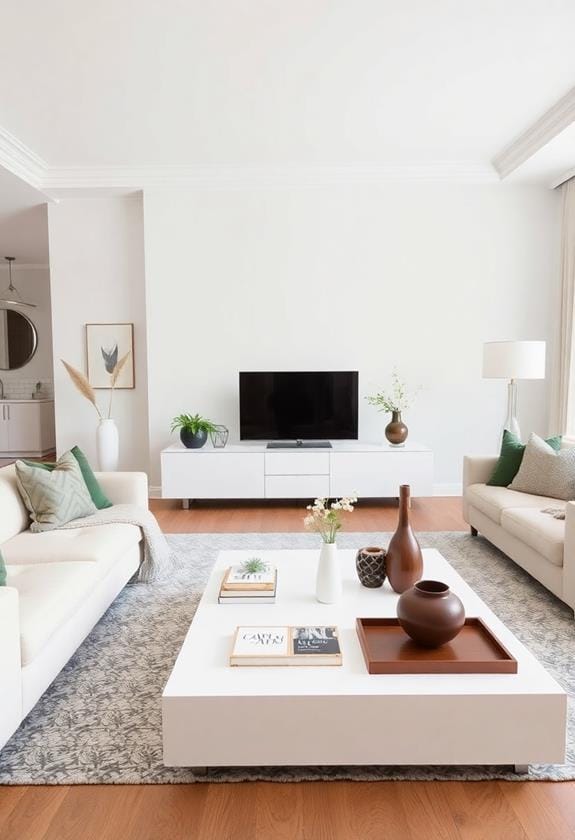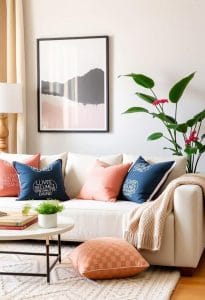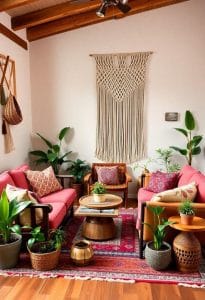Transforming your home with modern decor is achievable with just a few key DIY steps. Start by choosing a color palette that sets the right mood—think calming blues or warm earth tones. Create a standout feature wall using themes and materials that speak to your style, like geometric designs. Upcycle old furniture by sanding, painting, and adding new hardware. Craft geometric wall art, and mix bold patterns in textiles for layers of interest. Install DIY modern lighting to enhance ambiance, and explore creative storage solutions like minimalist shelving. Incorporating personal touches in window treatments can tie everything together beautifully. Discover the full potential of your space with these insights.
Key Points
- Choose a cohesive color palette using a color wheel and test swatches for optimal mood setting.
- Create a feature wall by selecting a theme and following a precise design plan.
- Upcycle furniture by sanding, painting, and updating hardware for a refreshed look.
- Design minimalist shelving with clean lines and organize items for aesthetic appeal.
- Make DIY lighting fixtures using materials like metals or glass, ensuring safety and ambiance.
Choosing the Right Color Palette
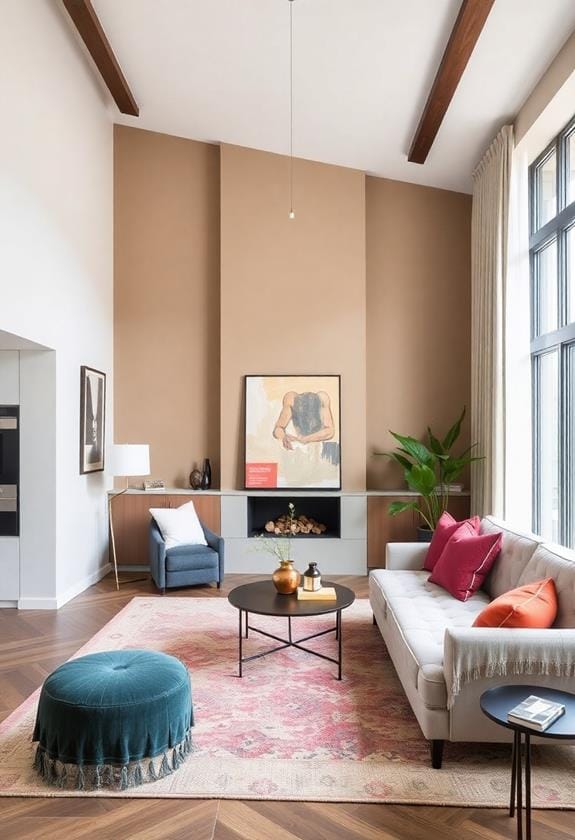
Selecting the right color palette is essential to setting the tone and mood of your home decor. When you choose colors, you're not just picking shades, you're crafting an atmosphere. Start by considering the function of each space. In a living room, warm tones like soft beige or muted reds invite comfort and conversation. For a bedroom, calming blues or gentle greens may promote relaxation, helping you unwind at the end of the day. According to the best home decor trends 2025, integrating earthy tones such as terracotta and olive green can also add a timeless and sophisticated touch to your space.
To guarantee harmony, select a primary color that resonates with you, then build a palette around it. Use a color wheel to find complementary hues, which will create balance and visual interest. Don't shy away from testing swatches on your walls; lighting can dramatically alter how a color appears throughout the day.
Think about how each room connects with the next. Consistent undertones, like warm or cool shades, can unify your home's aesthetic. Accessories, such as throw pillows or curtains, can echo these colors, tying everything together seamlessly. Remember, it's your personal taste that ultimately guides your choices; trust your instincts. By thoughtfully selecting your color palette, you'll transform your living space into a cohesive, inviting sanctuary.
Creating a Feature Wall
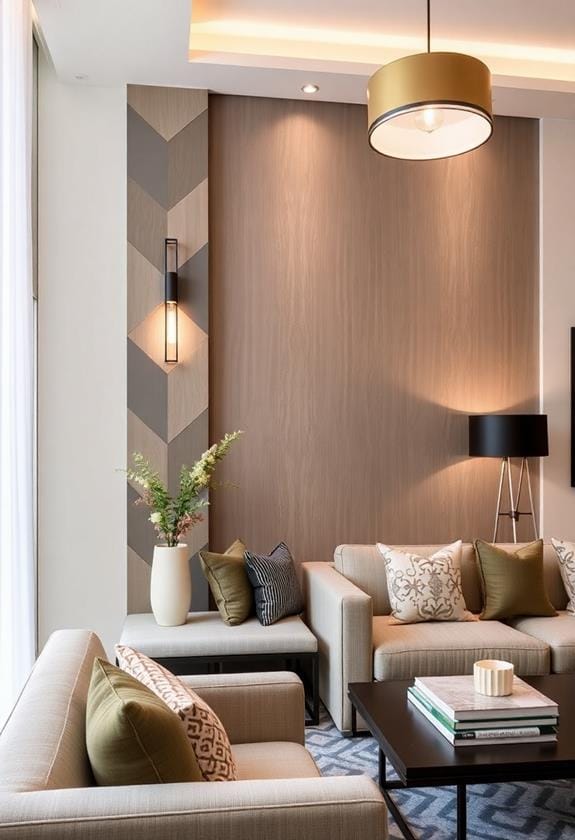
Transforming a plain wall into an enchanting feature is a powerful way to inject personality into your home. A feature wall can become the focal point of any room, drawing attention and sparking conversation. By incorporating DIY modern home decor ideas, you can achieve a designer look without the high cost. Start with a clear vision of what you'd like to accomplish, whether it's a bold, vibrant look or a subtle, textured masterpiece. Here's a simple process to guide you:
- Choose Your Wall: Select a wall that naturally grabs attention, maybe one behind a sofa or in a dining area. This will guarantee your feature wall stands out and complements the room's layout.
- Pick a Theme: Consider what resonates with your style. It could be anything from geometric patterns to a rustic wood paneling finish. This theme will set the stage for the rest of your decor.
- Gather Materials: Depending on your theme, you might need paint, wallpaper, wood panels, or even stencils. Make sure everything is ready before you start, to avoid interruptions.
- Start Creating: Begin with prepping the wall, making certain it's clean and smooth. Then, follow your design plan with precision, taking your time to get it just right.
DIY Modern Lighting Fixtures
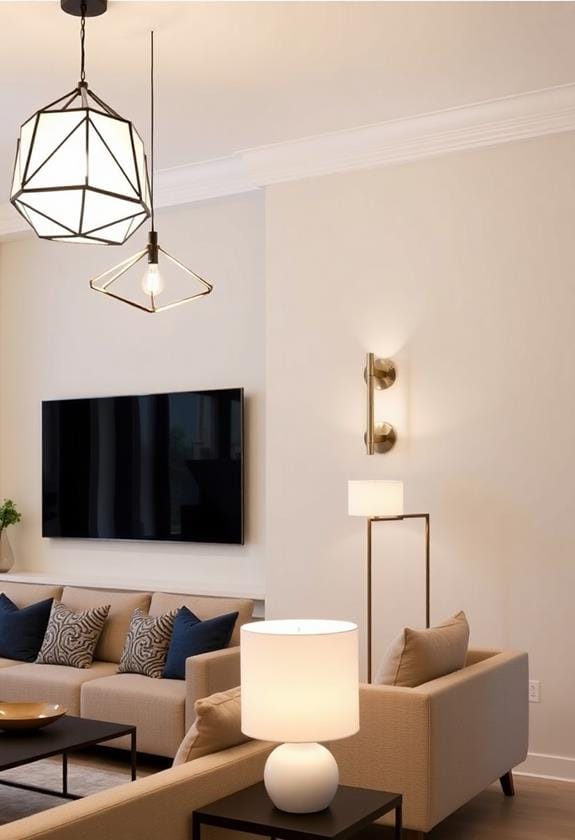
Once your feature wall is ready, it's time to enhance the ambiance with DIY modern lighting fixtures. Lighting plays a vital role in setting the mood of your space, and crafting your own fixtures adds a personalized touch. Start by choosing the right materials; think about lightweight metals, wood, or even recycled glass. These materials not only align with modern aesthetics but are also easy to work with. For those seeking luxurious lighting solutions, exploring premium options can inspire your DIY projects and elevate your home's ambiance.
Next, consider the type of lighting you need. Pendant lights, wall sconces, and floor lamps each offer distinct benefits. Pendant lights are great for highlighting specific areas, like a dining table, while wall sconces add subtle, ambient light. If you're aiming for a statement piece, a floor lamp with an unusual design can serve as both a light source and a conversation starter.
When assembling your fixture, ascertain safety is a priority. Always use proper electrical components and follow wiring instructions carefully. Experiment with different bulb types—LEDs are energy-efficient and come in various color temperatures, allowing you to tailor the light's warmth. By crafting your own lighting, you're not just illuminating your home; you're creating an atmosphere that reflects your unique style.
Upcycling Furniture With Style
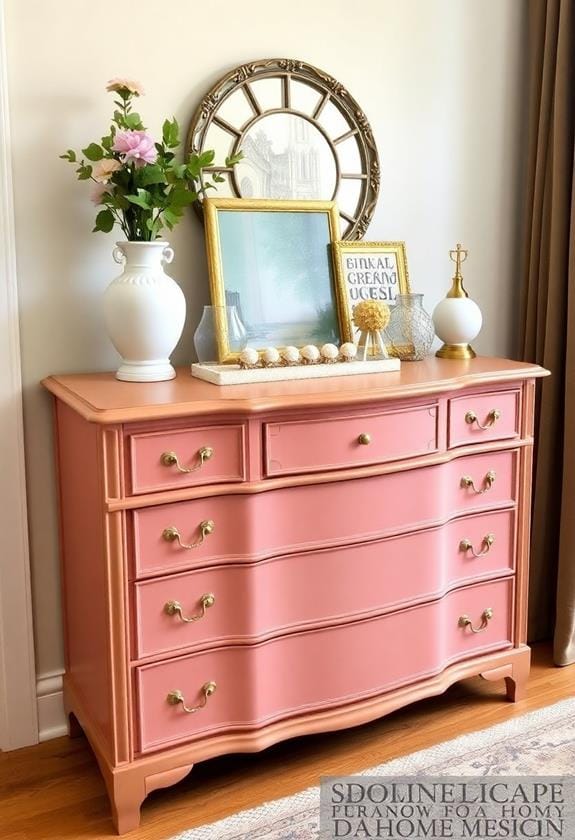
Upcycling furniture with style is an art that allows you to transform outdated pieces into stunning, modern decor. By incorporating creativity and a bit of elbow grease, you can achieve remarkable results. Imagine taking an old, worn-out chair or a tired dresser and infusing them with your unique flair. Here's how you can get started:
- Assess and Plan: Evaluate the piece's condition, envision its potential, and decide on the style you wish to achieve. This could range from shabby chic to sleek and modern. Consider exploring different upcycling techniques, such as adding twine or jute for a rustic texture, as seen in upcycling glass bottles.
- Prepare the Surface: Sand down rough spots and clean thoroughly. This is essential for a smooth, long-lasting finish. Don't skip this step, as it guarantees paint or varnish adheres properly.
- Choose Your Colors and Patterns: Selecting the right colors can make all the difference. Go bold with vibrant hues or maintain simplicity with neutral tones. Patterns can add visual interest.
- Add Finishing Touches: Hardware like knobs or handles can be replaced or repainted. This simple change can elevate the entire piece's appearance, giving it a fresh, cohesive look.
Crafting Geometric Wall Art
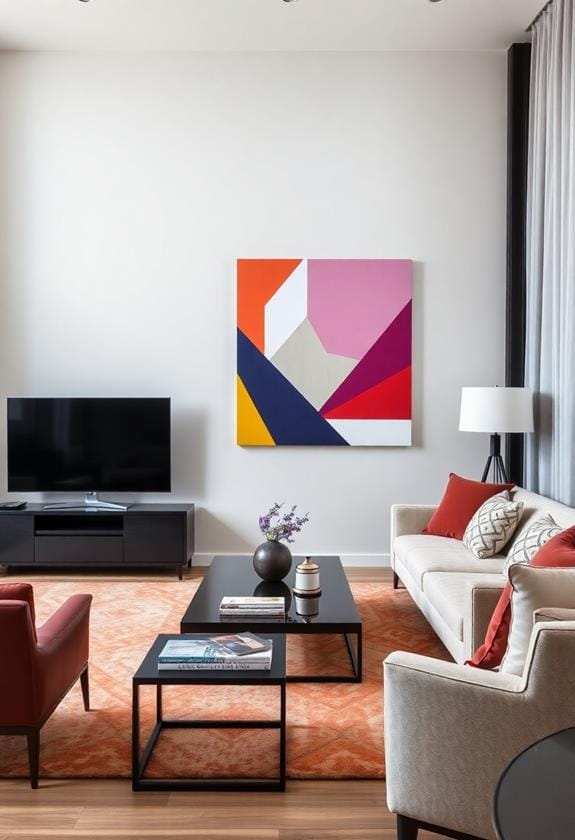
After breathing new life into your furniture, turn your attention to the walls with the creation of geometric wall art. This project adds a modern touch to any room, and it's both fun and rewarding. Start by selecting your color palette—think about hues that complement your existing decor. For inspiration, consider exploring simple DIY wall art ideas which can transform your space effortlessly. Next, gather materials: canvas or wood panel, painter's tape, and acrylic paints. These items offer the flexibility to experiment with different shapes and patterns.
Begin by taping off sections on your canvas to form geometric shapes. Consider triangles, rectangles, or even more complex polygons. The tape acts as a guide, ensuring crisp lines once you remove it. Apply your chosen paint colors within these taped areas, letting each layer dry before moving on to the next. This patience is key to achieving a neat, polished look.
Once the paint dries completely, carefully peel away the tape to reveal your design. Take a step back and admire your creation, adjusting any areas if needed. With minimal effort and cost, you've added a personal touch to your space. Display your artwork proudly, knowing you've enhanced your home with style and creativity.
Designing Minimalist Shelving
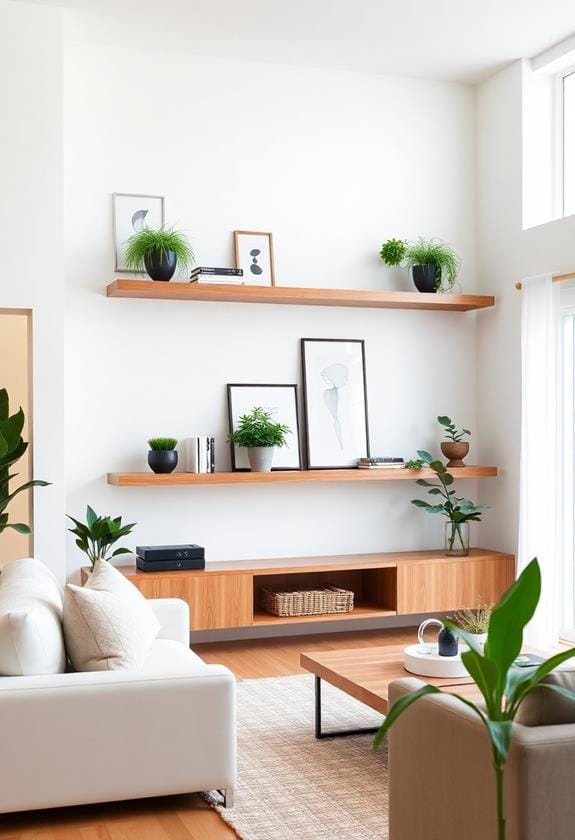
Minimalist shelving can transform your space by offering both functionality and sleek design. It's about using clean lines and simple materials to create an organized haven. First, decide on the type of shelves that suit your room. Whether floating, ladder, or built-in, each offers unique benefits. For example, built-in shelves can maximize your space by fitting seamlessly into your room's architecture, making them a great choice for small spaces. Here's a step-by-step guide to help you design your own minimalist shelving:
- Choose Your Material: Opt for materials like light wood, metal, or glass. These materials contribute to a clean, airy look that's perfect for a minimalist aesthetic.
- Measure Your Space: Carefully measure the area where you'll install your shelves. This guarantees that your shelves fit perfectly and align with your room's dimensions.
- Design Layout: Sketch your desired layout, focusing on symmetry and balance. Consider the spacing between shelves and how this impacts both form and function.
- Install Thoughtfully: Use quality hardware and tools. Guaranteeing shelves are level and secure not only looks better but also keeps your items safe.
Making a Statement With Textiles
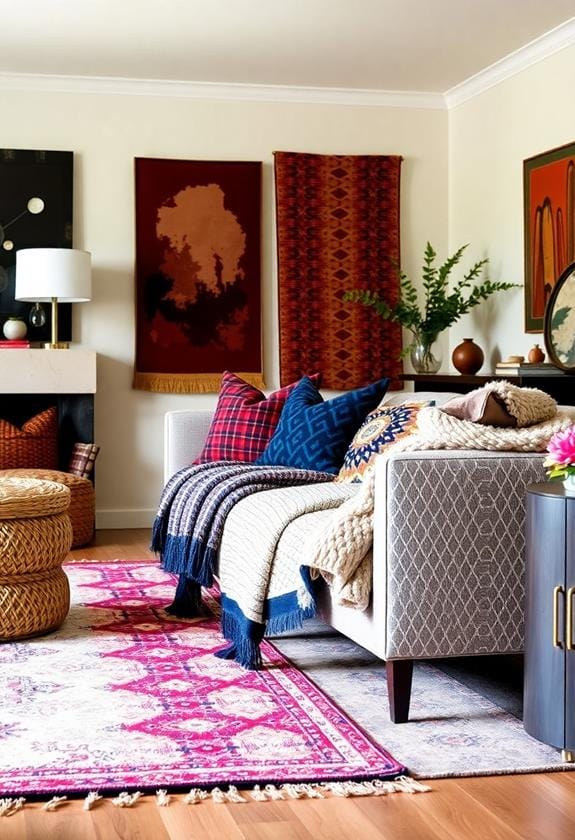
With the right textiles, you can instantly transform any room into a vibrant and inviting space. Start by choosing bold patterns or rich textures that reflect your personal style. Whether it's a plush area rug, colorful throw pillows, or a luxurious blanket, textiles add depth and character. Opt for fabrics that contrast or complement your existing decor, creating a cohesive yet dynamic look. For inspiration, luxurious decor ideas can provide a wealth of options to enhance your living room's aesthetic.
To make a statement, consider layering different textiles. For instance, drape a patterned throw over a solid-colored sofa or mix various pillow sizes and textures on your bed. This approach not only adds visual interest but also gives the room a cozy, lived-in feel. Pay attention to the colors you select, ensuring they either stand out as focal points or blend subtly for a harmonious effect.
Don't forget about window treatments, as they can dramatically affect the ambiance. Sheer curtains let in natural light, creating an airy atmosphere, while heavier drapes provide warmth and privacy. Additionally, consider incorporating textiles in unexpected places, like fabric wall hangings or upholstered furniture, to further enhance your space. With thoughtful selection, textiles can truly be the finishing touch that ties your entire decor together.
Revamping Old Cabinets

As you finish adding the final textile touches to your living room, you might notice that your old cabinets could use a fresh look to match the updated decor. Revamping them is a manageable project that can greatly enhance your space. First, gather your supplies: paint, sandpaper, new hardware, and a screwdriver. Now, you're ready to transform those tired cabinets step by step.
- Prep and Clean: Begin by removing all doors and hardware from the cabinets. Clean the surfaces with a mild detergent to eliminate grease and grime. This step guarantees that the paint adheres properly, giving you a smooth finish.
- Sand and Prime: Lightly sand the cabinet surfaces to remove the old finish. Wipe away the dust with a damp cloth, then apply a primer. Priming is essential as it helps the new paint stick better and last longer.
- Paint with Care: Choose a color that complements your room's palette. Use a brush or roller for even application, and let each coat dry thoroughly before applying the next.
- Reassemble and Admire: Once the paint is dry, reattach the doors and install new hardware. Stand back and admire your refreshed cabinets, now seamlessly integrated into your modern home decor.
Handmade Decorative Planters
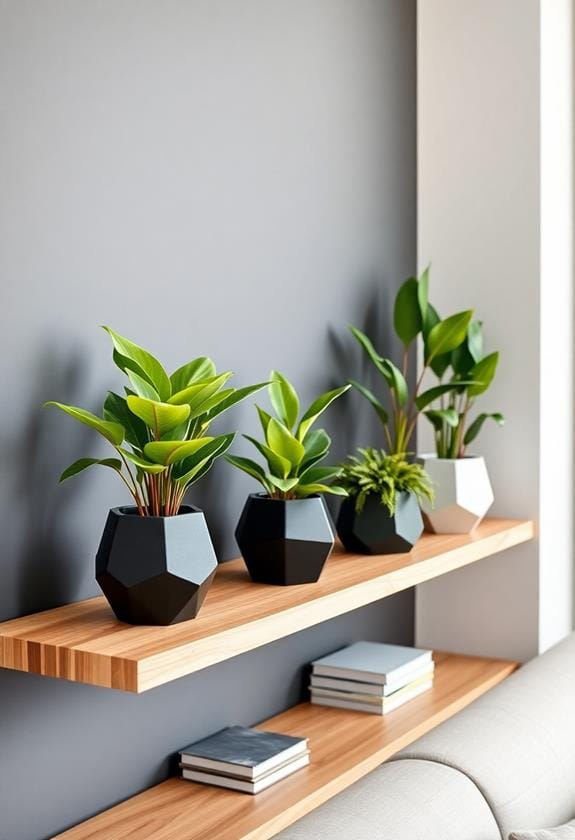
Creating handmade decorative planters is a delightful way to infuse personality and greenery into your home. Whether you're a seasoned DIY enthusiast or just starting out, crafting your own planters allows you to tailor them to your aesthetic preferences and the space you have available. Begin by choosing materials that complement your existing decor—think terracotta for a rustic feel or sleek ceramics for a modern touch. You can even repurpose items like tin cans or wooden crates to create unique, personalized planters.
Once you've selected your materials, consider the size and type of plants you'll be using. Verify your planter has adequate drainage to maintain healthy plant roots; drilling holes in the bottom is often necessary. You'll also want to use quality potting soil suited to your plant type, as this promotes growth and longevity.
To add a decorative element, consider painting your planters with vibrant colors or intricate designs. If you prefer a more natural look, a simple stain or varnish can highlight the material's texture. Finally, position your planters in areas where they can thrive, such as near windows with ample sunlight, verifying they become a seamless part of your home's decor.
Simple DIY Window Treatments
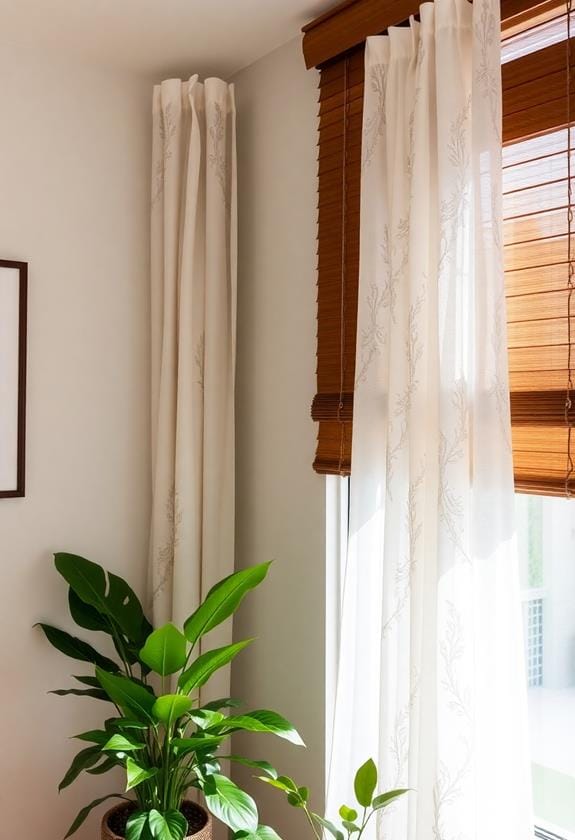
Transforming your windows with simple DIY treatments can dramatically enhance the ambiance of any room. Whether you're seeking privacy, better light control, or just a fresh look, these easy projects can make a big difference without breaking the bank. Start by considering the style and function you want to achieve, then gather your materials and tools. Here are four simple ideas to get you inspired:
- No-Sew Curtains: Use fabric glue or iron-on tape to hem your chosen fabric. Attach curtain rings with clips to hang them effortlessly on a rod. This method provides a custom look without sewing skills.
- Roman Shades: Cut and attach fabric to a mini blind's slats using fabric glue. Fold the fabric to create a classic Roman shade effect that adds elegance to any window.
- Frosted Glass: For a modern, minimalist look, apply frosted glass spray or adhesive film. This technique offers privacy while allowing natural light to filter through beautifully.
- Bamboo Blinds: Hang bamboo blinds for a natural, earthy vibe. They're easy to install and can be adjusted to let in the perfect amount of light.
These treatments not only beautify your space but also reflect your personal style.
Frequently Asked Questions
How Do I Determine My Overall Home Decor Style Before Starting DIY Projects?
"Home is where the heart is," so start by exploring what inspires you. Look around your space and pinpoint elements you love. Is it a minimalist vibe or a cozy, eclectic feel? Create a mood board with colors, textures, and furniture styles that speak to you. Consider your lifestyle and daily habits—do you need a functional workspace or a relaxing retreat? This process will help clarify your unique decor style, guiding your DIY projects.
What Are the Best Online Resources for Sourcing Affordable DIY Materials?
You can find affordable DIY materials online through various resources. Websites like Etsy and eBay offer unique and budget-friendly options, while Amazon provides a diverse range of materials often at competitive prices. Don't overlook Facebook Marketplace and Craigslist for local deals on used items. Additionally, Pinterest can inspire where to source materials creatively. Always compare prices, read reviews, and check shipping costs to guarantee you're getting the best deal possible.
How Can I Safely Use Power Tools in Home Decor Projects?
Picture power tools as the heartbeat of your DIY projects, pulsing with potential. To wield them safely, guarantee you're wearing protective gear—gloves, goggles, and sturdy shoes. Always read the manual, it's your best friend. Secure your materials firmly, and double-check your workspace for hazards. Keep a first-aid kit nearby, just in case. Stay focused; distraction dances with danger. With these steps, you can harness power tools safely and confidently.
What Are Some Tips for Maintaining Balance and Harmony in DIY Home Decor?
To maintain balance and harmony in DIY home decor, start by choosing a consistent color palette, which ties different elements together. Don't overcrowd spaces; guarantee there's room to breathe by spacing out furniture and decor items. Incorporate varying textures for visual interest, but keep them cohesive. Use symmetry in arrangements for a calming effect, and balance large pieces with smaller accents. Regularly step back to assess the overall look, making adjustments as needed.
How Do I Plan a Budget for a Complete Home Decor Makeover?
Start by evaluating your financial limits, then prioritize which rooms need the most attention. Make a list of essential items, like furniture or paint, and research their costs. Don't forget to allocate funds for unexpected expenses, and consider DIY projects to save money. Always compare prices and look for sales or discounts. By planning carefully and staying flexible, you'll achieve a stylish makeover without breaking the bank.

